- Earnings can cause volatility, despite being backward-looking.
- When Powell speaks this week, will he settle the market debate on whether the Federal Reserve has pivoted?
- Dollar hit its highest weekly close since 2002 while euro neared parity, aiming much lower.
- Gold fell every day last week, while Bitcoin may have started its next leg down and oil confirmed trajectory to $60.
-
Any company’s financials for the last 10 years
-
Financial health scores for profitability, growth, and more
-
A fair value calculated from dozens of financial models
-
Quick comparison to the company’s peers
-
Fundamental and performance charts
Next week will be one of those that will be impossible to predict. I can see two equally valid scenarios leading up to Friday's Jackson Hole economic symposium. There is a market debate on whether there is a Federal Reserve pivot - that is, if the U.S. central bank intends to slow its rate of hiking interest rates.
Fed chief Jay Powell will speak on Friday at 10am EDT, and investors will undoubtedly be attentive to every word and intonation of the Fed's boss. The question is: Will stocks be in a holding pattern until investors receive guidance from policymakers? Or will traders try to outguess each other, taking advantage of bargains, depending on their point of view? Dip buyers will abound among those who believe the rebound is the bottom of an eventual bull market, whereas persistently suspicious traders will sell rallies.
Earnings
That said, earnings can move markets, as they satisfy bulls' confirmation biases - even though they are backward-looking - during the worst inflation over four decades and unprecedented tightening. Granted, you could make the same argument about technical analysis. After all, a trend is made up of previous prices.
It's a valid question. Technical analysis does not claim to be able to tell the future. The discipline uses up-to-date pricing and compares with volume, momentum, and previous pricing to create a picture based on the preponderance of the evidence. The theory relies on statistical outcomes to provide a trajectory - not the future.
On Tuesday, JM Smucker (NYSE:SJM) and Intuit (NASDAQ:INTU) are set to release corporate results. On Wednesday, Advance Auto Parts (NYSE:AAP), Salesforce (NYSE:CRM), and Nvidia (NASDAQ:NVDA) are scheduled to report earnings. Finally, on Thursday, Dollar Tree (NASDAQ:DLTR), Dollar General (NYSE:DG), and Ulta Beauty (NASDAQ:ULTA) are set to publish their report cards.
Analysts expect $4.9 EPS and $2.19B revenue figures for Ulta Beauty. The company beat revenues in seven recent quarters and earnings in nine. Will it keep its positive streak?
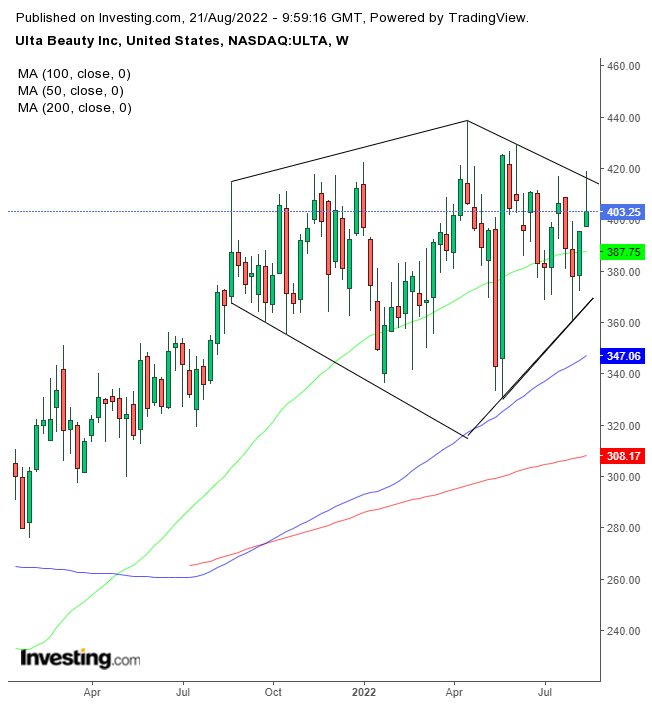
Source: Investing.com
The stock may develop a diamond, a top formation, with a downside breakout.
Inflation Data
The Bureau of Labor Statistics is set to publish the personal consumption expenditures (PCE) price index on Friday at 8:30 EDT. The PCE measures the price of a basket of household goods and services, and it's the Fed's preferred inflation gauge. The last report showed PCE rose 6.8% in June from the year before - the highest rate since January 1982.
Monetary Policy
The market priced in a 54.5% probability of another 50-basis-point hike at the Federal Open Market Committee meeting in September and a 45.5% chance of a 75-basis-point increase, according to the CME FedWatch Tool. In other words, if investors feel that the Fed is deviating from these bets and the central bank pays attention to market expectations, the market will react accordingly.
Moreover, Fed Chair Jerome Powell, should he choose to accept the task, is poised to settle the market debate. On the one hand, Fed members have been reiterating that they will not stop raising interest rates until they see clear evidence that inflation is down - and the Fed cares about core inflation, not volatile food and energy prices. On the other hand, Powell said in a July 27 press conference that the Fed would consider slowing rate hikes at some point. Also, Powell said that the Fed's policy would be to decide on rate increases on a "meeting-to-meeting basis," not via providing "forward guidance."
As a result, many in the market took this to be the Fed's "dovishing," but I think that's ludicrous. The Fed will of course slow down rate hikes at some point, but as Powell clarified, this should only occur after it sees compelling evidence that inflation has fallen. Moreover, Powell said he'd tolerate a recession if that's what is needed to get the job done.
In that context, changing the policy from forward guidance to data dependency simply frees the Fed from having to lock in expectations. In other words, I argue that this freedom will make it easier for the Fed to raise interest rates more quickly, not slower, to get the job done, even if it means a recession. Note that Powell will speak after the release of the PCE data. So, it will be interesting how he'll weave in that information. Of course, if the Fed does turn dovish, and I'm wrong, stocks could erase this year's losses.
I have been obstinately bearish, to the chagrin of many. Readers and social media users have characterized me with insults like "perma-bear." I'd like to remind everyone that we are still in a bear market, and I have been... bearish... in a bear market. To be fair, the Nasdaq 100 and the Russell 2000 gained over 20%, making for an accepted bull market. However, the S&P 500 and the Dow Jones Industrial Average have not. Also, the 20% gauge has no significance in technical analysis. It's just an arbitrary number that somehow stuck on Wall Street.
There is no causative reasoning attached to that figure, and the market has whipsawed between this gauge of bull and bear markets repeated without any direction. In last week's post, I sourced The Big Short's Michael Burry, who correctly shorted the 2008 and this year's crashes. The S&P 500 experienced its worst first half since 1970. Now, he's adamant that we are in a bear market rally which is a bull trap, and ridicules the 20% rally for the Nasdaq. The legendary investor underscores that the tech-heavy gauge enjoyed several 20%+ rallies while still crashing in the dot-com bubble burst.
Technicals
Small-caps and big tech took the greatest hit last week. The Russell 2000 underperformed, plunging 2.7%, just one week after outperforming with a whopping 4.7% weekly gain. The Nasdaq 100 was last week's second-worst performer, losing 2.4% after having gained 2.7% in the prior week. So these two swung the other way, according to market sentiment, but the Dow Jones Industrial Average outperformed, retreating a mere 0.2% - but what's noteworthy is that this followed a week of 3.1% gains, making it the second-best performer after small-caps.
In other words, value and defensive stocks were the only sectors that outperformed for two straight weeks. We see the same pattern among the S&P 500 sectors, where consumer staples provided the best results, adding 1.85% of value, followed by utilities' 1.3% gain. On the other hand, communication services plunged 3.1%, making this tech sector the worst weekly performer.
Nevertheless, all four major averages were rejected by the 50-week moving average after crossing the 100-week MA. Even the Dow Jones showed bearish signs with its two-weeks superior performance.
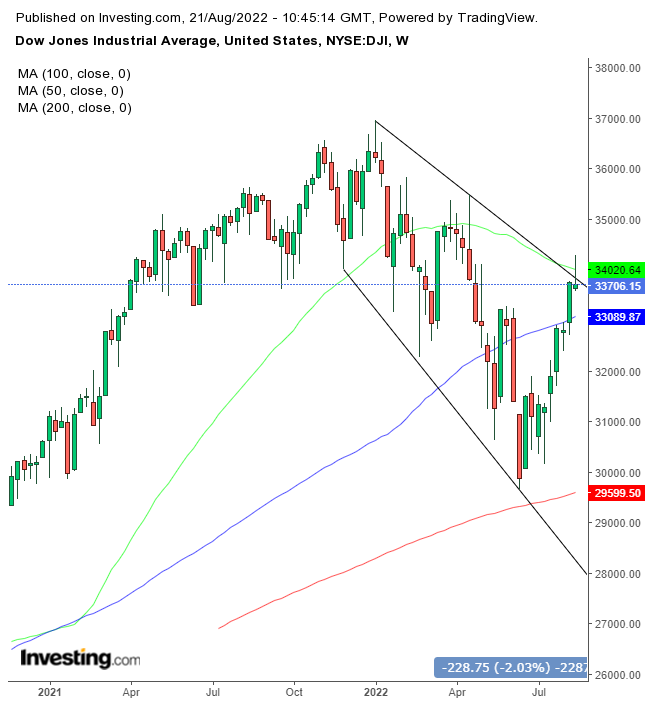
Source: Investing.com
The Dow formed a weekly shooting star - even after that superior performance - and peaked above but closed below the 50 WMA, reinforcing the falling channel top.
Just because I use technical analysis does not mean that all chartists agree with me. Technicians point out that the recent rally had breadth, as the number of stocks with new highs surpassed those with new lows. The number of S&P 500 stocks that crossed above the 50-day MA reached 90%, considered bullish, along with other indicators.
However, I will be comfortable turning bullish only after the weekly chart shows rising peaks and troughs.
Ten- and 30-Year U.S. Treasury yields climbed Friday for the third week in a row, with the former hitting monthly highs and the latter reaching six-week highs. The move came after Richmond Fed President Thomas Barkin said the Fed would do whatever it takes to get inflation under control. Traders repriced yields accordingly by selling off long-dated bonds, raising their yields as they waited for bonds that reflect higher interest rates.
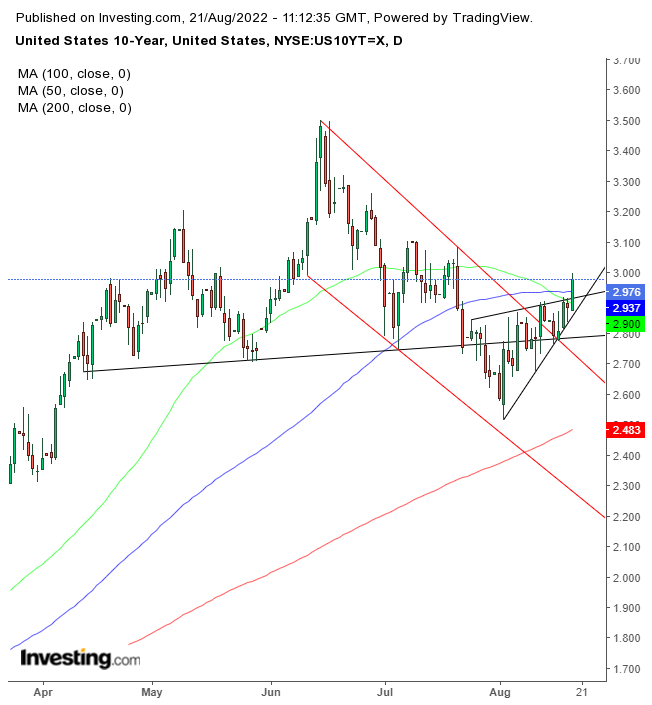
Source: Investing.com
The move appears to have blown out a bearish wedge, which already broke a falling channel's topside. If the price persists, it will blow out a head-and-shoulders top, propelling it even higher, reflecting higher interest rates.
A part of the yield curve remains inverted, with the ten years at 2.076% and the two years at 3.238%.
The U.S. dollar climbed for the fifth session out of the past six, erasing four weeks of losses in the space of a week and reaching its highest level since July 14. However, on a weekly-close basis, the greenback hit its highest price since October 2020! Conversely, the euro neared parity again, 0.2% above the lowest since 2002, to a level it already fell to on a weekly close basis.

Source: Investing.com
The single European currency may have completed a rising flag after a massive H&S continuation pattern, which coincided with an exceedingly bearish weekly death cross when the 50-week MA crossed below a falling 200-week MA. The last time the 200 WMA fell below a falling 200 WMA, in December 2014, the euro plunged nearly another 16% till March 2015, just three months later.
Gold fell for five straight days, back below the 50 DMA - after the MA itself fell below the 200 DMA, triggering a death cross. The 100 DMA crossed below the 200 DMA as well. That put the major MAs in a bearish pattern, as each MA is below a longer one, demonstrating a breakdown in pricing across the board. Gold is losing out on the dollar's rising yield.
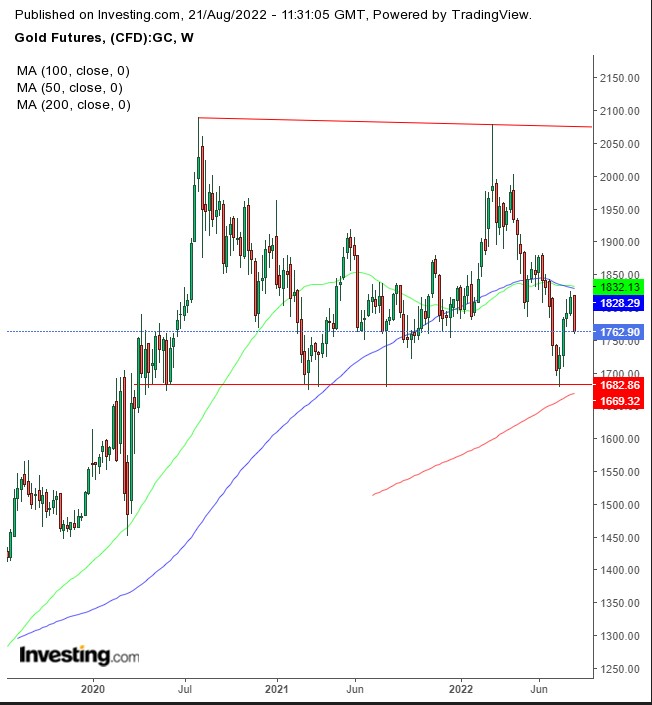
Source: Investing.com
The yellow metal erased more than two weeks of gains after nearing the 100 WMA, which crossed below the 50 WMA. The price has been on a trajectory to the bottom of a range since April 2020, protected by the 200 WMA.
Bitcoin plummeted 13.5%, wiping out four weeks of gains as the yielding dollar rose in attractiveness.
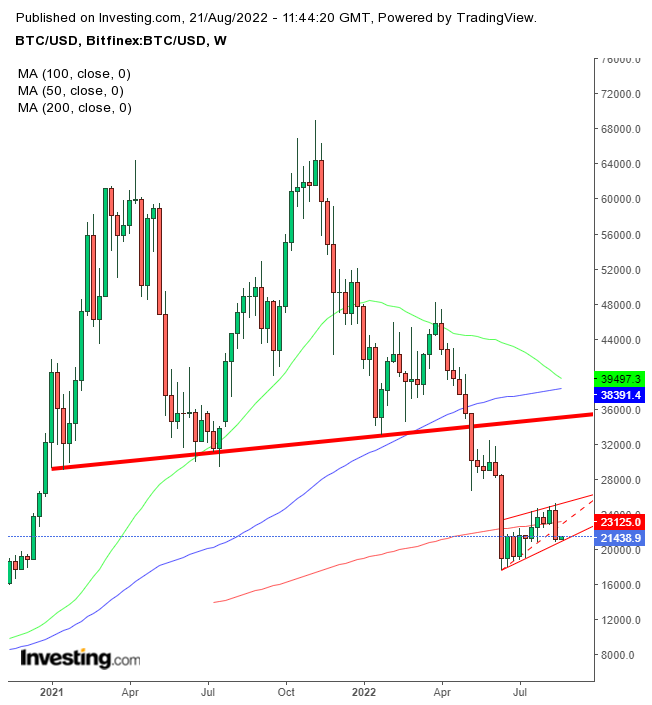
Source: Investing.com
The cryptocurrency leader may have completed a rising wedge (dotted red line). Still, cautious traders will consider the lower boundary of that bearish pattern, including the outlier of price action. The price fell below the 200 WMA after being supported for four weeks. Notice how it acted as resistance within the wedge before that. If my initial interpretation of the rising wedge holds, based on the stippled dots, Bitcoin may be ready for its next leg down after having reached my corrective rally's target.
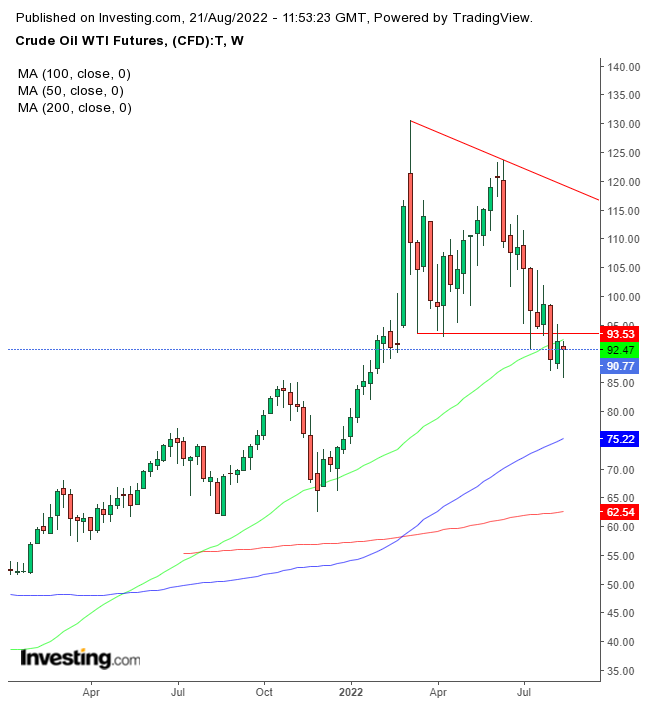
Source: Investing.com
WTI retreated from an attempt to climb back into a descending triangle, targeting $60.
***
Looking to get up to speed on your next idea? With InvestingPro+ you can find
And a lot more. Get all the key data fast so you can make an informed decision, with InvestingPro+. Learn More »
